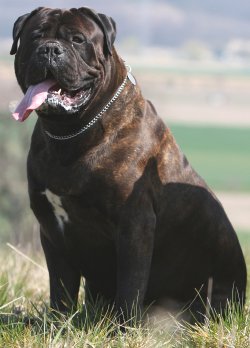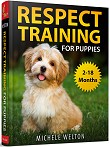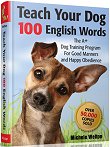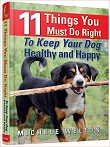Honest FAQ for Bullmastiffs
By Michele Welton, Dog Trainer, Behavioral Consultant, Author of 15 Dog Books

Compared to the English Mastiff, the Bullmastiff is smaller and stockier, more active and agile, more confident, more of a thinking dog, and potentially more aggressive.
What kind of temperament and personality does the Bullmastiff have?
The most descriptive words that come to my mind regarding Bullmastiff temperament and behavior are:
usually calm and quiet (adults), confident, self-assured, determined, strong-willed, loyal, protective, can be aggressive (especially toward other animals), slobbery, gassy
I give you my honest opinions about Bullmastiff temperament and personality traits and characteristics – positives AND negatives – in my dog breed review, Bullmastiff Temperament and Personality Traits (What's Good About 'Em, What's Bad About 'Em).
What were Bullmastiffs used for?
The Bullmastiff, along with other mastiffs such as the Cane Corso, Old English Mastiff, Neapolitan Mastiff, etc. are descended from a very old class of dogs known as Molossans or Molossers.
It is thought that ancient Greek Molossan tribes were the first to breed massive dogs for guarding, for war, and for fighting other animals "for sport." Because invasions and conquests were so common, these huge dogs became dispersed throughout Europe and crossed with native breeds to form a mastiff variety specific to that particular area.
Here is why (and how) the Bullmastiff was developed. During the 1800s, on the wealthy country estates and game preserves in England, a powerful, fearless dog was needed as protection against poachers
Thus the Bullmastiff was developed by crossing mastiffs (60%)with old-style fighting bulldogs (40%). The new 60/40 breed began accompanying gamekeepers on their rounds and was suitably called "the gamekeeper's night dog".
What traits would help Bullmastiffs accomplish their work? That's right... powerful drives to confront and drive off strangers and other animals, great physical strength, endurance, courage and tenacity, high tolerance for pain, independent thinking, and loyalty.
Most of the ancestral Bullmastiff traits (strength, bravery, tenacity) are still in the DNA of modern Bullmastiffs. But most of the ferocity has been bred out.
How big are Bullmastiffs? Height and weight?
About 24-27 inches at the shoulder, and 100-140 pounds, which means they straddle the LARGE and GIANT categories. Unfortunately, they share the short lifespan (7-10 years) of other giant breeds.
What colors do Bullmastiffs come in?
Red, fawn, or brindle (black stripes on a red or fawn background).
On some brindle Bullmastiffs, the stripes are few in number but clearly defined. On other brindle Bullmastiffs, the stripes are so numerous and heavily concentrated that you can hardly see the red/fawn background peeking through, i.e. the dog might appear black, especially from a distance. The latter dogs are, in fact, often called "black" brindles or "reverse" brindles.
Do Bulllmastiffs have a doggy odor?
Sometimes... but not from their skin or coat. Rather, all of the mastiff breeds tend to be flatulent/gassy.
How much exercise do Bullmastiffs need?
Moderate exercise. The Bullmastiff doesn't want or need hours of running. He is satisfied with an hour a day of brisk walking, plus an occasional vigorous romp in a decent-sized fenced yard. (I do not take Bullmastiffs to off-leash dog parks; the risk of a fight is too great.)
Many other large breeds can get great exercise playing fetch, but unfortunately Bullmastiffs don't have much interest in such games.
You might be able to enourage them to play Tug-of-War... but with such a powerful dog, you should be careful. Play Tug the wrong way and you could cause or exacerbate dominance/aggression issues. Play it the right way, though, and it can be a great exercise/bonding experience for the both of you. My book, Teach Your Dog 100 English Words, explains how to teach Tug properly.
Do Bullmastiffs need a fenced yard?
Yes, with a high solid fence. See-through fences, unless you live in a really private area, encourage barking and aggression. See-through fences also allow strangers of the dognapping persusasion to see what a potentially valuable breed you have.
More on Why a fenced yard? and best and worst fences.
Are Bullmastiffs easy to train?
Yes and no. If you are an assertive person who can "read" and respond to a strong-willed working dog and establish a healthy leader-follower relationship, most Bullmastiffs are very willing to work with you.
Oh, they might be a bit hard-headed at times, but if you stand your ground every time ("I'm in charge and you must follow my rules"), your Bullmastiff's behavior should be fine.
On the other hand, if you're more of a mild-mannered, peaceful, live-and-let-live kind of person... don't get a Bullmastiff. He will run the household and you're likely to see increasing aggression issues going forward, which puts other people and animals at risk. This breed is a terrible choice for passive folks.
Are Bullmastiffs easy to housebreak?
They're fine.
Are Bullmastiffs friendly with people?
Some Bullmastiffs are outgoing with everyone. But many are intensely loyal to their own family and standoffish with strangers. Some Bullmastiffs have "harder" or "softer" temperaments than others.
Most Bullmastiffs have protective instincts, but without actual protection training, they are not effective protectors. But they can still be excellent deterrents... as long as you stay in charge and immediately stop any unwarranted aggression.
For both ethical and legal reasons, you should require your Bullmastiff to be polite (i.e. well-mannered, non-aggressive) with everyone who is not a bad guy! For example, it's okay if the dog doesn't happen to like one of your friends or neighbors. But he must not act on those feelings with barking or threatening behaviors.
Are Bullmastiffs good with children?
Many Bullmastiffs are patient with children. And yet... I don't recommend Bullmastiffs for children younger than about 10 years old. This is a strong, vigorous breed that could accidentally knock over a small child.
In addition, the bulldog-type breeds can have issues of resource guarding, which means being possessive of their food and chew toys. I don't allow small children (or other pets) near a Bullmastiff who is engrossed in his food or bones.
And let's not just sweep under the rug the reality that aggression is hardwired into the DNA of these powerful mastiff breeds. It's the reason they were created. If your kids are roughhousing with or have a heated dispute with their friends, a Bullmastiff can't be expected to know whether it's harmless or not. Dogs are wonderful creatures, but they can't read minds.
Are Bullmastiffs good with other dogs?
If you're a strong leader, Bullmastiffs will usually be fine with other dogs in their own family... other dogs of the opposite sex, that is. Even if you're a strong leader, I don't recommend keeping this breed with another dog of the same sex. Bullmastiffs can be very dominant and pushy toward other dogs of the same sex.
Also, because of the strong prey drive of some Bullmastiffs, it's a risk to keep those individuals around very small dogs who might run.
Personally, I prefer to see this breed kept as an only dog.
Are Bullmastiffs good with cats?
I would not keep a Bullmastiff with a cat unless the two were raised together from puppyhood/kittenhood.
How much do Bullmastiffs shed?
Bullmastiffs are average shedders. Their short coat sheds moderately in the spring and fall, plus a bit of hair the rest of the year. This is typical of shorthaired breeds.
Are Bullmastiffs hypoallergenic? Good for people with allergies?
Absolutely not.
How much grooming do Bullmastiffs need?
Just an occasional quick brush to sweep the dirt, dander, and loose hair off your dog's skin. More frequent brushing when shedding.
However, when you own a mastiff-type breed, grooming is more than just brushing. On a regular basis you should monitor the loose folds of skin on the dog's head, especially around his lips. A slobbery dog produces a lot of saliva – now combine that with wrinkles, and you end up with dark, moisty, dirty hiding places for parasites, bacteria, and fungi. So keep these areas thoroughly clean and dry.
What's a good training schedule for training Bullmastiff puppies?
Here's the puppy training schedule I use for Bullmastiffs: Puppy Training Schedule.
What behavior problems do Bullmastiffs tend to have?
The worst problems occur during adolescence (7-24 months) when the hormones are building. Don't make the mistake of leaving a young Bullmastiff alone and loose in the house, instead of properly crated/penned/safe.
This critical adolescent period is when you must teach calmness, establish the right leader/follower relationship, and respond properly to behavior problems.
Once through adolescence, as long as you've established the right relationship and you're providing sufficient exercise and companionship, Bullmastiffs don't misbehave much.
When they do, the issues tend to center around resource guarding (possessiveness of food or chew toys) or dominance/aggression, usually toward other animals, but occasionally toward people.
What health problems might Bullmastiffs have?
Loose hip and elbow joints can cause lameness and crippling arthritic pain. Same with cruciate ligament rupture. And bone cancer, which is almost always fatal. And gastric torsion (bloat) is always a worry in large dogs with deep chests, like Bullmastiffs.
What breeds are similar to the Bullmastiff?
- English Mastiff
- American Bulldog
- Cane Corso
- Dogo Argentino
- Dogue de Bordeaux
- Tosa
- Rottweiler
- Greater Swiss Mountain Dog
Where can I buy a Bullmastiff puppy?
From a show breeder is best, but that breeder MUST be able to show me the proper health certifications on both parents. Read my article to learn what those are.
Where can I adopt an older Bullmastiff?
I am a strong advocate of adopting dogs from Rescue groups. But with this powerful breed, I personally wouldn't do that. I would too concerned about the unknowns: which behavioral and health traits the dog may have inherited, how well (or poorly) he was raised and trained, his mental and emotional stabillity.
Adopting from the pound or animal shelter is even riskier, as you have no idea what that dog might turn out to be like. Rescue groups have at least been fostering their dogs in normal homes, so they have a better idea what the dog might be like in a family setting. Still too risky for my taste, but you might feel differently.
So... rescue group or humane society/shelter? Read my article.
I just got a new Bullmastiff. Which pages should I read first?
- Bullmastiff Health, which includes my advice on feeding, vaccinations, and daily health care. These pages are very important, because if you start your Bullmastiff puppy off on the wrong foot, he will probably experience health problems later on. Starting off right is essential.
- Training Bullmastiffs, which includes my advice on respect training, housebreaking, and socialization. Again, you must start your Bullmastiff puppy off on the right foot by teaching him what he needs to know, and you must avoid doing the wrong things with him so that he doesn't develop bad habits that will be much harder to fix later on.
Do male dogs or female dogs make better pets?
Ah, let the debate begin! Honestly, male Bullmastiffs have pros and cons, and female Bullmastiffs have pros and cons. Visit Male Dogs versus Female Dogs
There's an adorable Bullmastiff puppy at the pet shop. The store manager assures me they only buy from responsible breeders. Could this be true?
No responsible Bullmastiff breeder would ever place one of their Bullmastiff puppies in a pet shop for resale. To find out more about pet shop puppies, visit Pet Shop Puppies: Buying a Puppy From a Pet Store.
How do I pick the best Bullmastiff puppy from a litter?
You can do puppy personality tests. Visit How To Choose a Good Puppy.
What's the best dog food for Bullmastiffs?
3 Best Ways To Feed Your Dog Healthy Food.
I have to take my Bullmastiff to the vet soon for shots. Which vaccinations does he really need?
The schedule of vaccinations that dogs really need has changed dramatically – but unfortunately most vets are not telling you this, because a good chunk of their income depends on frequent vaccinations. Please don't get any more shots for your Bullmastiff until you've read my article on Puppy Shots and Dog Vaccinations.
What are the pros and cons of spaying and neutering my Bullmastiff, and when should it be done?
Spaying and neutering are often recommended too early, which can lead to health problems later in life. Visit Spaying Your Female Dog or Neutering Your Male Dog for the straight scoop on the safest (and riskiest) times to spay or neuter.
I have a question about Bullmastiffs that I don't see answered on your web site.
It's probably answered in one of my free online books.
My best-selling books – now available FREE on my website
 Respect Training For Puppies: 30 seconds to a calm, polite, well-behaved puppy is for puppies 2 to 18 months old. Your puppy will learn the 21 skills that all family dogs need to know. Click here to read for free.
Respect Training For Puppies: 30 seconds to a calm, polite, well-behaved puppy is for puppies 2 to 18 months old. Your puppy will learn the 21 skills that all family dogs need to know. Click here to read for free. Teach Your Dog 100 English Words is a unique Vocabulary and Respect Training Program that will teach your adult dog to listen to you and do what you say. Click here to read for free.
Teach Your Dog 100 English Words is a unique Vocabulary and Respect Training Program that will teach your adult dog to listen to you and do what you say. Click here to read for free. 11 Things You Must Do Right To Keep Your Dog Healthy and Happy helps your dog live a longer, healthier life. Get my honest advice about all 11 Things before you bring home your new puppy, because some mistakes with early health care cannot be undone. Click here to read for free.
11 Things You Must Do Right To Keep Your Dog Healthy and Happy helps your dog live a longer, healthier life. Get my honest advice about all 11 Things before you bring home your new puppy, because some mistakes with early health care cannot be undone. Click here to read for free.

